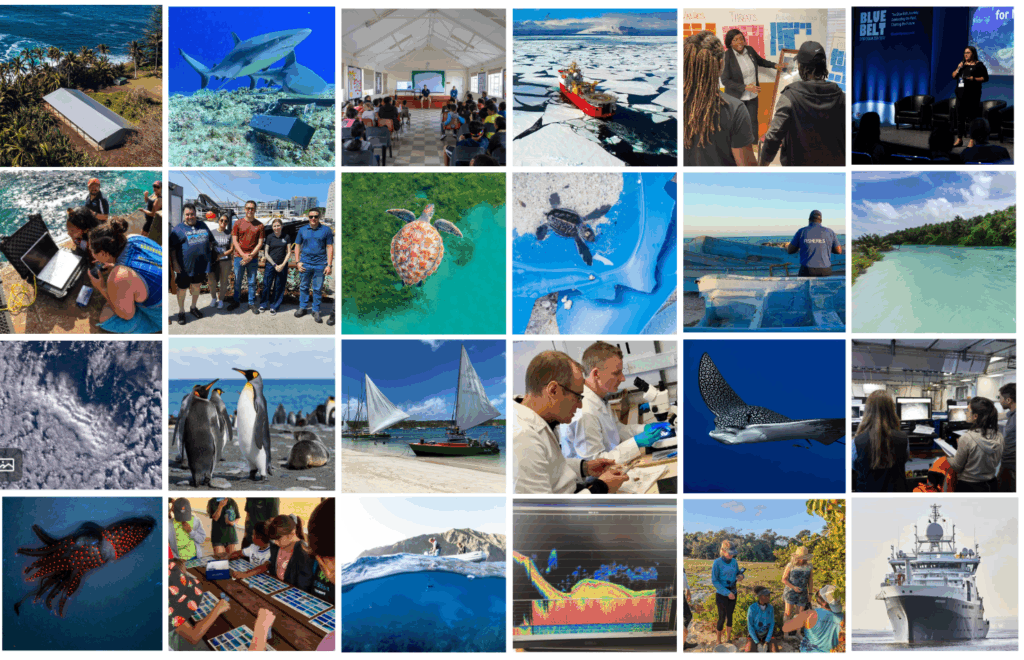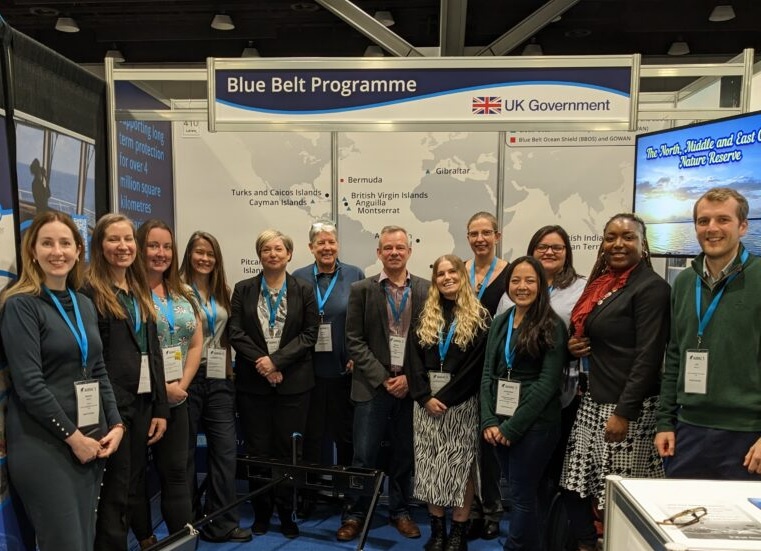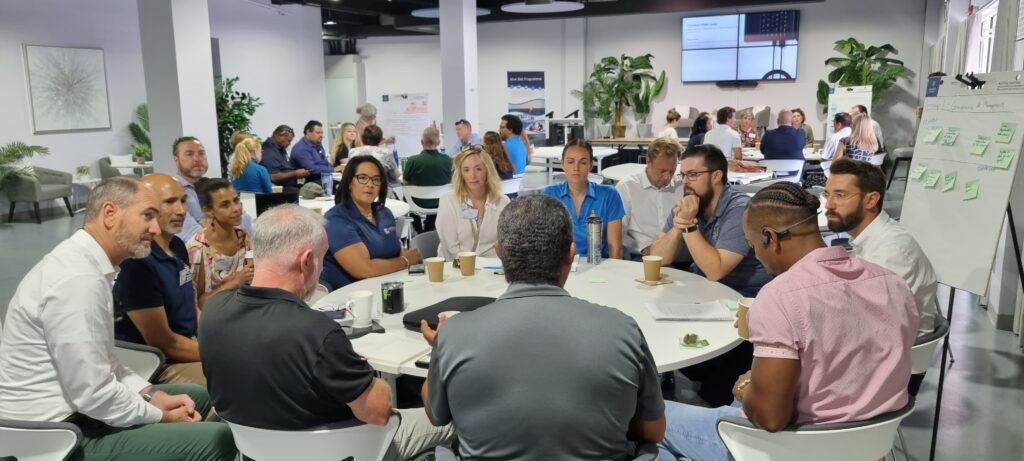
Since its initiation in 2016, the UK Government’s Blue Belt Programme has been at the forefront of global marine protection, working closely with the UK Overseas Territories (UKOTs) to establish and manage one of the largest networks of marine protected areas (MPAs) in the world.
With the start of a new campaign to celebrate the Programme’s 10 year anniversary in 2026, we spoke with Blue Belt’s three programme leads — Kylie Bamford, Head of Marine Conservation at the Foreign Commonwealth and Development Office (FCDO), Sim Archer-Rand, Blue Belt Programme Director at the Centre for Environment Fisheries and Aquaculture Science (Cefas) and Jamie Davies, Blue Belt Programme Director for the Marine Management Organisation (MMO)— to reflect on the Programme’s origins, challenges, and achievements so far.
Q: Let’s start at the beginning. How did the Blue Belt Programme come about?
Kylie: The initiative was inspired by the UK’s long-standing commitment to ocean conservation and recognition of the vast amount of biodiversity held within the UKOTs, some of which are found nowhere else on earth. Together the UK and UKOTs manage the world’s fifth largest marine estate globally. By 2015, it was increasingly recognised that these waters were globally significant yet vulnerable to climate change, pollution and biodiversity loss. Given the territories’ remoteness, small populations and dependence on marine resources, the UK Government saw both a need and opportunity to provide meaningful support. In response, the Blue Belt Programme was initiated in 2016 to translate this vision into action. Since then, it has grown in alignment with global ocean conservation efforts and now plays a key role in supporting the UK’s commitment to protecting 30% of the world’s ocean by 2030.
Sim: Blue Belt was also born out of increasing recognition of the importance of protecting the waters around the UKOTs and builds on decades of work by scientists, local UKOT communities, and conservationists who had been calling for stronger protection of marine ecosystems. The Programme therefore brings together a wide range of scientific and marine management expertise from across Cefas, MMO, OT Partners, communities, governments, and experts.

Q: How has the programme evolved since the beginning?
Jamie: It’s been great to see the Programme grow. We started with 5 members and now we support 10 UKOTs from across every major ocean basin. It’s been exciting to expand our presence in the Caribbean, welcoming Turks and Caicos in 2022, and Anguilla and the Cayman Islands to the Programme in 2023. And we are looking forward to continuing to support and build on UKOTs achievements under our new strategic themes — so watch this space for info.
Kylie: The success of the Blue Belt Programme lies in its tailored, multifaceted support. Each OT has unique needs, and the Programme’s flexible approach ensures local priorities are addressed while contributing to global ocean conservation targets. A major milestone came in 2021 with the launch of two sub-programmes — the Global Ocean Wildlife Analysis Network (GOWAN) and the Blue Belt Ocean Shield. GOWAN has become one of the world’s largest underwater camera networks, capturing millions of hours of footage to enhance marine protection. Its data recently supported the Pitcairn Islands in achieving IUCN recognition as an Important Shark and Ray Area (ISRA). Meanwhile, the Blue Belt Ocean Shield focuses on maritime domain awareness in order to tackle illegal fishing, which not only threatens the marine environment, but also impacts people’s livelihoods.
Q: What have been some of the biggest challenges facing the programme
Kylie: Establishing and managing marine protected areas is a complex and incredibly challenging task, especially in very remote areas. It involves far more than simply drawing lines on a map. Effective MPA management must protect biodiversity, strengthen resilience against the impacts of climate change, and support local communities by providing food security, sustainable livelihoods and economic opportunities. There is no ‘one size fits all’ solution, which is why the Programme offers a full suite of support. This includes strengthening governance frameworks, developing robust monitoring and enforcement systems, building partnerships with Territory governments, and ensuring that sound science underpins MPA management in the UKOTs.
Jamie: Monitoring and surveillance are no small task: they involve surveying vast stretches of ocean with satellites, drones, and patrol vessels, while trialling innovative tools like acoustic sensors. The challenge lies not only in collecting this data, but in supporting the UKOTs to use it effectively for enforcement and compliance. A big part of our work has been training local staff to carry out fisheries inspections, patrols, and intelligence gathering, so they can take the lead in protecting their waters. And with technology like AI advancing at breakneck speed, keeping pace is both a challenge and an opportunity!
Sim: Linked to what Kylie just said, I think one of the biggest challenges is working in different contexts and local environments. Each UKOT has unique needs and priorities. For example, supporting sustainable fisheries might be critical in one territory, while in another it’s about developing a marine spatial plan or addressing threats like marine plastics. A big part of our role is listening, learning, and tailoring our support to ensure it delivers for each UKOT.

Q: Looking back, what achievements stand out most to you?
Kylie: There are so many, it is difficult to choose! The sheer scale of marine protection achieved is truly remarkable. Working alongside the OTs, we’ve helped safeguard nearly 4 million square kilometres of ocean. These waters include some of the most biodiverse marine ecosystems on the planet — from the vibrant coral reefs of the Pitcairn Islands to the deep sub-Antarctic waters around South Georgia & the South Sandwich Islands.
Sim: Tristan da Cunha is a standout example for me. In 2020, the Territory created one of the largest fully protected marine reserves in the Atlantic Ocean. That decision came after years of collaboration with the community. Also, some of our offshore scientific surveys, for example in St Helena and Ascension in 2022 , have helped to generate the evidence needed to support effective MPA management in areas typically inaccessible to inshore vessels.
Jamie: For me, it’s the advances in technology and monitoring. The Programme has pioneered the use of satellite surveillance, drones and data analytics to track activity across these vast waters. That’s allowed enforcement officers to spot illegal fishing and respond quickly. It’s an area where the Blue Belt has been genuinely innovative.

Q: What lessons have you learned that could inspire future ocean conservation efforts?
Sim: One lesson is the importance of partnership. None of this would have been possible without the commitment of the UKOTs themselves. They are the custodians of these waters, and their leadership has been central to the Programme’s success.
Kylie: Another is that bold ambition has proven to be a powerful catalyst for change. When the Programme first launched, many questioned whether protecting such vast ocean areas was truly achievable, or whether they would be ‘paper parks’. Yet by aiming high, these small island communities have demonstrated what is possible – setting a global example and inspiring marine conservation efforts around the world.
Jamie: I don’t think the learning stops. The ocean is constantly changing, and so are the pressures it faces. The Blue Belt programme has shown that long-term commitment, adaptability, and collaboration are essential if we’re going to safeguard these waters for future generations.

Q: Looking ahead, what’s next for the Blue Belt Programme?
Jamie: We are excited by the next phase of the Programme which comes into implementation in 2026. While protecting nature will still be a core focus on the Programme, we will be expanding our climate change work and support to local communities to grow local blue economies to ensure MPAs are sustainable. We also have some exciting project milestones coming up, so make sure you follow our channels and this blog for updates.
Sim: Building international partnerships. Through the UKOTs and Blue Belt Programme, the UK has shown real leadership, however the challenges of protecting the ocean continue to grow. A key focus will be supporting the UKOTs both on the global stage but also locally to share experience and lessons learnt and inspire other UKOTs and other countries to work towards the global target of protecting 30% of the ocean by 2030.
Kylie: Ultimately, the Blue Belt Programme is about legacy. As we enter the next phase our goal is clear: to ensure that future generations — in the UK and across the UKOTs— inherit oceans that are richer in biodiversity, healthier in function, and more resilient to climate change. This vision is what drives our work every day. And in 2026, we look forward to celebrating this journey our UKOT partners and supporters – honouring the progress we’ve made and the promise of what’s still to come.
- Follow @UKGovBlueBelt on Twitter
- Like @UkGovBlueBelt on Facebook
- Subscribe to the Blue Belt Programme newsletter
- Read the Blue Belt Programme blog
- For any further information, email bluebelt@cefas.co.uk
1 comment
Comment by Jeremy Williams posted on
Excellent work. Keep it up. Save our marine ecosystem.